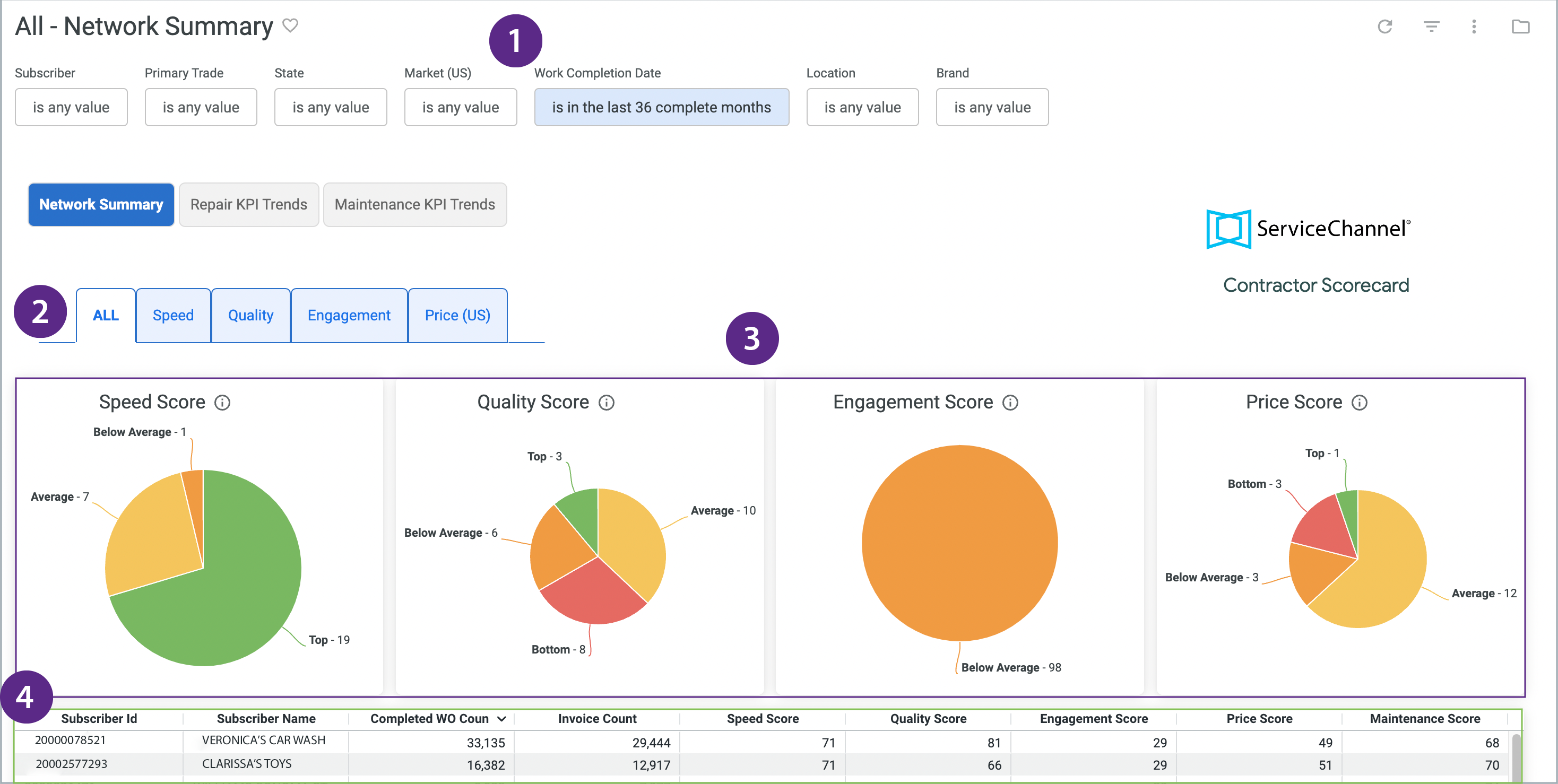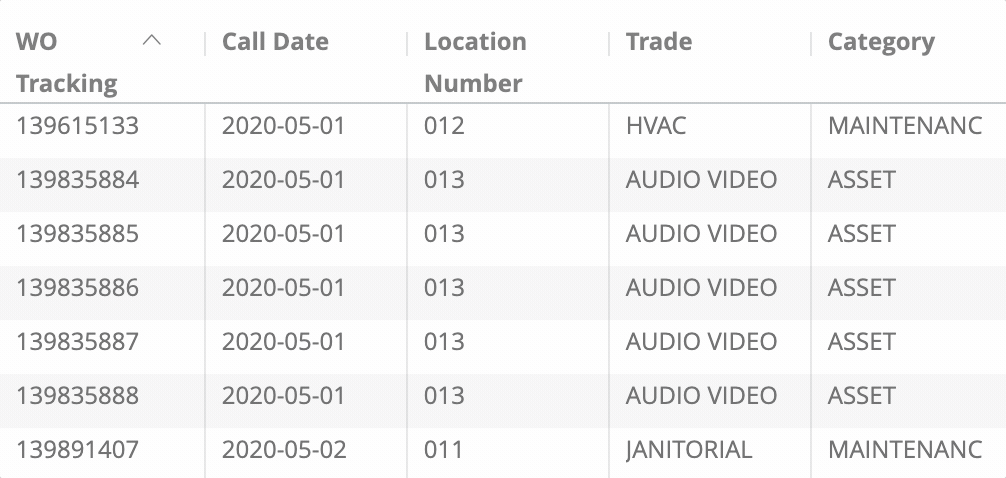All Tab
The ALL tab of the Network Summary Dashboard in Contractor Scorecard 2.0 allows you to see at a high level your overall performance against the entire ServiceChannel platform of providers. View your whole client network, filter to a singular provider, trade, area, etc. This dashboard is a powerful tool to give you a quick insight on where you can improve across your client network. It is also another area to talk about with your clients during performance reviews .
.
Repair Work Orders unsafe-Only
Data shown here are for repair work orders only unless otherwise specified.
Sections:
- Filters
- Performance Category Tabs
- Platform Wide Performance Tiers
- Scores per Subscriber Details Table
To view Score Calculations, jump on over to Contractor Scorecard 2.0 Calculations.
Filters
Refine and deepen your insights by filtering for specific subscriber(s), trades, geographic area, date range, location, and brand.
Subscriber Name: You can filter for a singular subscriber for a review or compare several subscribers.
Primary Trade: Search by one trade or several similar trades to get insight on trade specific performance.
State: View providers by state(s).
Market (US): Search for providers in Core Based Statistical Areas (CBSA). CBSAs are geographic regions defined by the US Office of Management and Budget that are anchored around urban centers of 10,000+ people along with adjacent counties that have strong social and economic ties to the urban center. This allows you to get a true comparison of provider performance, particularly around cost and speed, as the environment is more similar in that area. For example, if you compared cost for providers in Dallas, TX, you get a more accurate picture comparing them amongst each other than if you compared Dallas providers to Fredericksburg, TX providers.
Work Completion Date: Default state is 36 complete months. You can filter to whatever date range suits your purpose, but you can not go beyond 36 months.
Location: Filter for work performed at certain locations.
Brand: Filter for certain brands in your portfolio.
When you filter to a specific data point, your specific data will be ranked against the entire ServiceChannel platform not just that specific data in the platform. Ex: If you filter to see the performance of your plumbers, the dashboard will show how your plumbers rank against the entire platform. It will not compare your plumbers against all plumbers. Stay tuned! That feature is coming out soon with Benchmarking!
Platform Wide Performance Tiers
View your overall performance across all four high level KPI categories: Speed, Quality, Engagement, and Score. Scores are broken down by performance tiers: Top, Average, Below Average, and Bottom. As you filter through, your performance data for all your clients will be displayed in the position where you rank across the entire platform. The numbers in each slice or bar indicate how many subscribers you are performing for at that level. You can drill into the charts by clicking on the pie slice or the vertical elipsis for specific data on your rank amongst all your clients.
Engagement and Price Score
The Engagement score will not change when you filter. The Price Score is linked to a median of invoices and therefore will always appear on the screen even when Speed and Quality Score do not.
Scores per Subscriber Details Table
View all filtered subscribers and your individual scores, work order counts, and invoice counts side by side in this table. In this view, you see not only the repair work order high level KPI scores, but also Maintenance scores, Completed Work Order Count, and Invoice Counts. This is especially helpful if you want to get a good look at how you are performing in a certain trade or area amongst all your clients. Like all tables in analytics, sort, filter, and click in on data as needed.
Commonly Used Features
Below is a quick reference guide regarding tracking numbers in the Scorecard, filtering, sorting, downloading data, and sending reports.
Tracking Numbers in Analytics
Throughout the Contractor Scorecard, you can drill down into visualizations to see the underlying data. In most cases, the tracking numbers related to that data are listed. You can click the tracking number to navigate straight to the work order details in Service Automation.
Filtering Dashboards
On top of the report are all-inclusive filters to help you hone in on key data. All reports on the page are affected by the criteria set in these all-inclusive filters.
The filter criteria for each dashboard may differ. Filters reset to the default when the page is refreshed.
Click the triangle next to Filters to show the criteria.

Select the desired criteria to include or exclude:
To Include criteria: select is equal to, contains, starts with, or ends with, and then begin typing the criteria in the picklist. Select the desired criteria (or multiple criteria) from the picklist.
To exclude criteria: select is not equal to, does not contain, does not start with, or does not end with.
Is null depicts the absence of data in a data set. Conversely, is not null depicts the presence of data
To include or exclude data without a certain data criteria — for example, to select data without a Region or District assigned in Service Automation — choose is blank / is not blank.
To add more options, click the plus sign (+) next to a field to add another option to the filter. The new option will appear as either an OR condition or an AND condition, depending on the type of filter option.
Once all criteria are selected, click Run in the top-right corner. The Dashboard report updates with the selected criteria.
More details are available on Filtering in the Contractor Scorecard.
Dynamic Table Sorting
Analytics tables are dynamic, as you can:
- click column and row headers to sort data (the arrow indicate which data is sorted),
- hover over a header to show the gear icon where you can interact with the data more dynamically, and
- drag and drop a header to rearrange the table.

Downloading and Sending Reports
In the upper-right corner of any page, click the Gear icon to download reports, send reports, or schedule reports to send at regular intervals.
![]()
You can download data from a table and visualization or download a dashboard tabto PDF or CSV.
- On the desired table or visualization, hover over the upper-right to expose the 3 dots menu, and then click Download Data. The Download modal appears.

Select the desired File Format and choose a File Name: A default name is listed but you can change it.
- Click Download.
On the desired dashboard (or dashboard tab), click the Gear icon in the upper-right of the page, and then click Download as PDF. The Download modal appears.
A default Filename appears, but you can change it.
Under Advanced options:
Single-column format lays out all tables and visualizations on a page into one column in the PDF, as opposed to how it is laid out in the dashboard.
Expand tables shows all rows in a table, instead of just the rows that appear on the dashboard.
Paper size adjusts the PDF to your desired size.
Click Open in Browser to view the PDF in your chosen browser, or click Download to save a version of the report onto your device.
On the desired dashboard (or dashboard tab), click the Gear icon in the upper-right of the page, and then click Download as CSVs... A new browser tab opens.
After the files render, you are prompted to save the CSV Zip file onto your device.
More details are available on Downloading and Sending Dashboards and Reports
You can also Send a one-time report via email or Schedule a recurring email send.
On the desired dashboard (or dashboard tab), click the Gear icon in the upper-right of the page, and then click Send. The Send (Dashboard Name) modal opens.
A Title is given by default, but you can change it.
Under Who should it be emailed to?, enter the desired recipient(s), separated by a comma, and then click Add.
(Optional) Click Include a custom message to add a personal note.
Under Format data as, choose PDF, Visualization, or CSV Zip file.
(Optional): Click Filters to limit the criteria that appear in the email. Note that the same filters on the dashboard itself will also appear here.
Click Send. The email is sent to your recipients.
On the desired dashboard (or dashboard tab), click the Gear icon in the upper-right of the page, and then click Schedule. The Schedule (Dashboard Name) modal opens.
A Title is given by default, but you can change it.
Under Who should it be emailed to?, enter the desired recipient(s), separated by a comma, and then click Add.
(Optional) Click Include a custom message to add a personal note.
Under Format data as, choose PDF, Visualization, or CSV Zip file.
Under Deliver this schedule, choose Daily, Weekly, Monthly, Hourly, or By minute (in 5-minute increments, up to 30 minutes)
(Optional): Use Filters to limit the criteria that appear in the email. Note that the same filters on the dashboard itself will also appear here.
Click Send. The email is sent to your recipients.
More details are available on Downloading and Sending Dashboards and Reports
-
Page:
-
Page:
-
Page:
-
Page:
-
Page:
-
Page:
-
Page:
-
Page:


